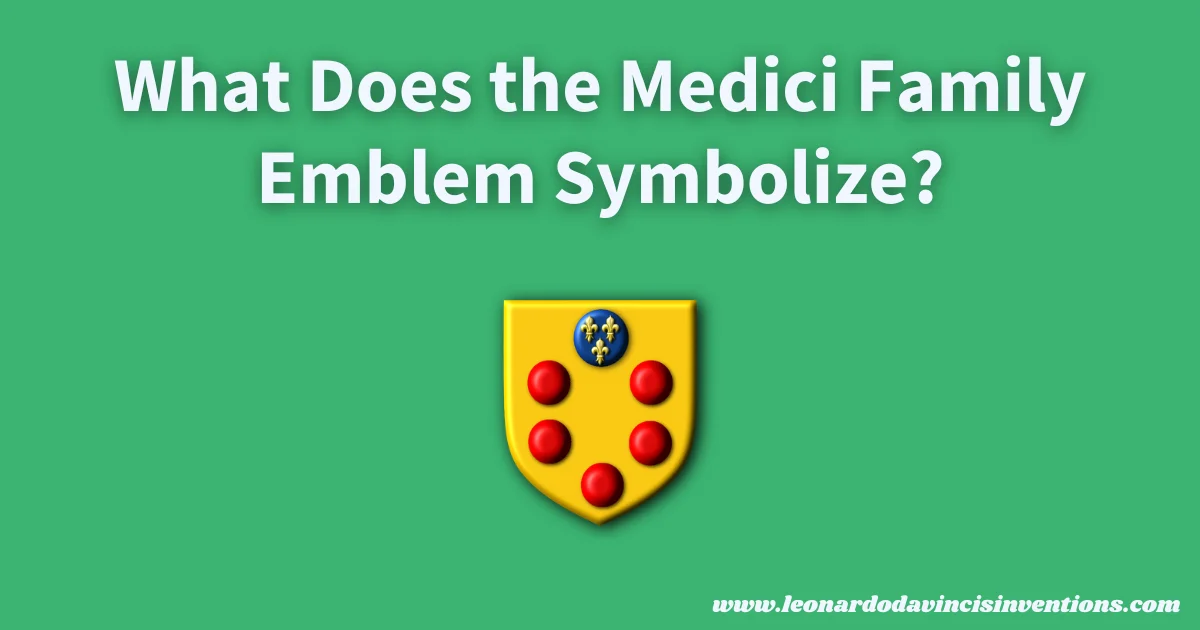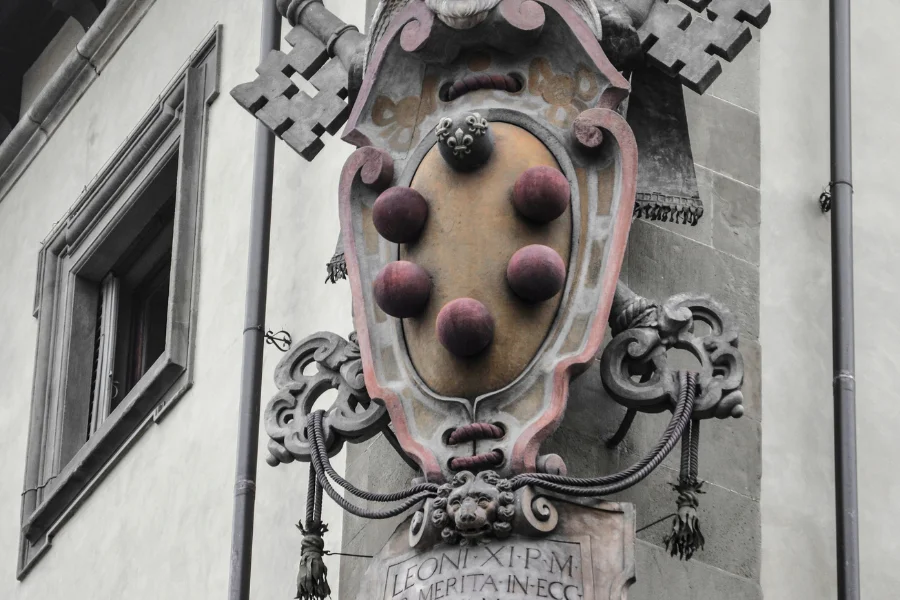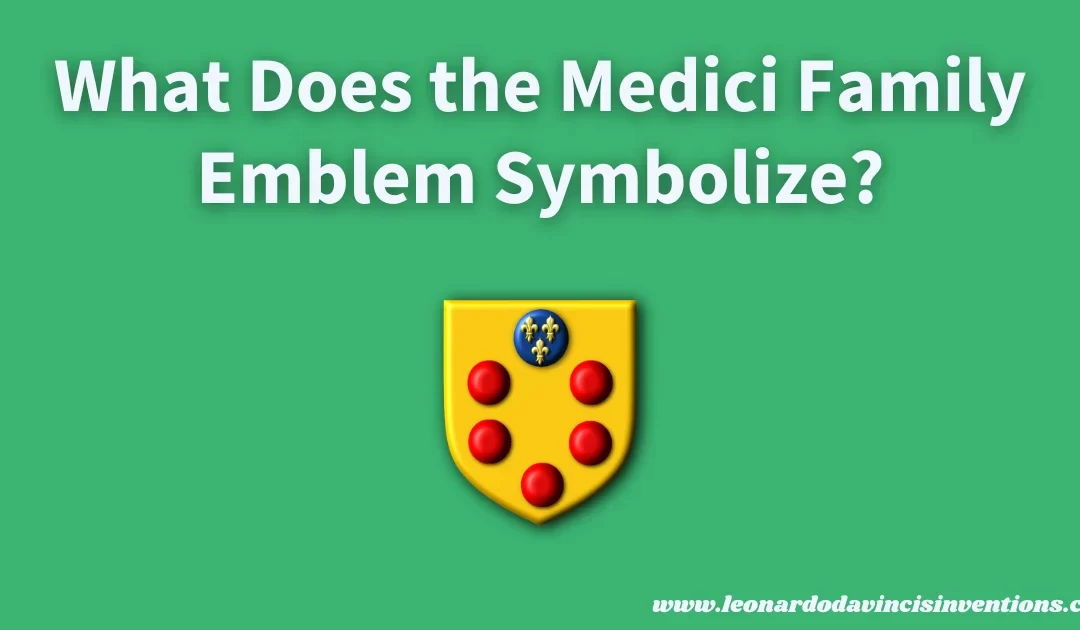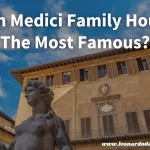
The Medici family emblem has fascinated people for centuries. Many wonder about its true meaning and the stories behind its design.
The emblem, which features five red balls and one blue ball on a gold shield, is most commonly believed to represent the family’s power, banking roots, and possible ties to medicine or trade.
If you have ever questioned what those mysterious balls stand for or the history hidden in their colors and shapes, you’re not alone.
Readers often seek clear answers about the Medici family symbol, but frequently find only confusing or conflicting stories. This article will help you get to the facts, including ideas about the balls as coins, medical pills, or signs of victory in battle.
You will uncover the real history and symbolism that can be found throughout Florence and Tuscany. The emblem appears in places like buildings and palaces where the Medici left their mark.
The Origins and Design of the Medici Family Emblem
The Medici family emblem is a powerful symbol of noble heritage and economic influence. Its design and symbolism are closely connected to the rise of Medici power in Renaissance Florence and their legacy in art, politics, and patronage.
Tracing the History and Meaning Behind the Coat of Arms
The Medici coat of arms first appeared in the 13th and 14th centuries as the family rose as a banking dynasty in Florence. The main element is a shield decorated with several round balls, called “palle.”
Historians believe the emblem changed over time as the family gained political power and recognition. Legends about the origin of the shield and balls vary.
One tale claims the marks are dents on a knight’s shield from a battle during Charlemagne’s rule. Another story suggests that the balls represent coins, highlighting the Medici’s roots in banking and finance.
While the true meaning remains debated, the coat of arms became a visual mark of Medici identity and status across Florence and Tuscany. The Medici emblem is visible on buildings, palaces, and artifacts funded by family members such as Cosimo de’ Medici and Lorenzo de’ Medici.
The Symbolism of Balls (Palle), Shield, and Ornaments
The balls or palle of the Medici coat of arms are its most famous feature. Typically, six red balls are arranged on a gold shield, with the top ball sometimes colored blue and marked with three golden fleurs-de-lis to honor the Medici ties to French royalty.
These balls may represent coins, reflecting the Medici bank’s wealth and influence in Renaissance Italy. Some interpret the balls as pills or blood drops, connecting them to the family’s roots in the medical profession, specifically doctors and apothecaries.
Ornamental flourishes and crowns often decorated the shield as their power grew. These additions signaled noble rank and connections to royalty, the papacy, and European courts.
Renaissance Iconography and the Influence of Heraldry
Medici heraldry drew upon elements shared by European nobility, but it became distinctly recognizable. The family’s emblem was displayed on public works, Medici palaces, and buildings throughout Florence.
Artists and architects incorporated the Medici family insignia into chapels, civic structures, and sculptures as symbols of patronage and civic pride. This widespread use made the Medici crest a badge of both private identity and public authority.
The coat of arms symbolized a blend of economic power, cultural influence, and proud heritage for the Medici dynasty.
The Medici Family Emblem’s Role in Power and Influence

The Medici family emblem, featuring the famous red balls, or “palle,” on a gold shield, signified their identity and ambitions in Renaissance Florence and Tuscany. This design appeared on palaces, coins, art, and public buildings, showing their political and economic reach.
Banking Dynasty and Wealth in Florence and Tuscany
The Medici family crest became a symbol of financial power in Florence. The Medici bank, recognized across Europe, used the emblem as its sign, marking its branches and documents.
Customers and rivals associated the red balls, or “palle,” with the stability and influence of this wealthy banking dynasty. Their rise was tied to banking innovations and their willingness to lend large sums to popes and European monarchs.
These connections increased both their wealth and status. The shield’s bold colors reflected their ambition and roots in Florentine heraldry, supporting their reputation for reliability and financial strength.
Political Power, Patronage, and Artistic Legacy
The Medici emblem appeared on civic projects, public artworks, and religious buildings, reflecting their impact on Florence’s political and cultural life. The patronage of artists such as Botticelli, Michelangelo, and Leonardo da Vinci helped define the Renaissance and spread the Medici insignia throughout Florence.
The Medici family used their coat of arms to legitimize political decisions, paving the way for family members like Cosimo de’ Medici and Lorenzo de’ Medici to lead the city. Their status as patrons earned them loyalty from citizens and artists, turning their family crest into a mark of authority and cultural prestige.
Medici Dukes, Popes, and the Family’s Royal Heritage
The Medici influence expanded beyond Florence as family members rose to become dukes, popes, and even royalty. The emblem spread to other Italian and European courts, symbolizing their fortunes and new noble status.
Medici popes such as Leo X and Clement VII brought the family’s symbol to the Vatican. The Medici coat of arms adorned papal documents and monuments, linking it to both religious and secular authority.
Their legacy, preserved in places such as the Medici Chapel and the Medici Palace, continues to define their role as cultural and political giants of Renaissance Italy.
The Lasting Legacy and Symbolism of the Medici Emblem
The Medici family emblem is one of the most recognized symbols of Renaissance Florence. It showcases a blend of heraldic power, artistic patronage, and dynastic pride.
Its significance is evident in art, legends, and modern culture, reflecting the enduring influence of the Medici family.
Medici Symbolism in Art, Architecture, and the Medici Palace
The Medici coat of arms, decorated with six red balls (palle) on a gold shield, is an emblem of the family’s banking legacy, nobility, and dominance in Florence. This design is evident throughout Florence in buildings they funded, such as the Medici Palace, the Medici Chapels, and churches associated with their patronage.
Artists from the Renaissance worked under Medici sponsorship, adding their crest to paintings, sculptures, and even furniture. These decorations helped link the Medici name to cultural achievement, wealth, and political power.
Their family insignia became a visual shorthand for their roots in banking and their ambition to control Tuscany and beyond.
Myths, Legends, and Interpretations Through History
Legends about the origin and meaning of the Medici emblem have spread for centuries. Some myths suggest the red balls represent blood, dents from a knight’s shield, or coins from the Medici banking empire.
Other tales associate the design with Charlemagne, portraying the Medici as warriors, while some interpret the balls as a symbol of the family’s connection to commerce and wealth. These stories built the Medici legacy and shaped their image as protectors and benefactors of Florence.
Each interpretation highlights aspects of their dynasty and history, from military valor to financial skill, making the emblem an adaptable symbol for Medici power.
Medici Emblem in Modern Culture and Its Enduring Significance
The Medici family crest remains a symbol of Tuscan heritage, still visible throughout Florence. Today, the emblem is found on street signs, public buildings, and souvenirs, testifying to the enduring influence of the Medici dynasty on art, architecture, and daily city life.
Its appearance in films, television series, and literature keeps the Medici legacy alive in popular culture. The family’s story of political power, wealth, and artistic influence continues to shape how people understand Renaissance Italy and its iconography worldwide.
Frequently Asked Questions
The Medici family emblem is most recognized for its series of balls, called “palle,” and often includes motifs like the fleur-de-lis. These symbols have roots in banking, politics, and powerful alliances that shaped Florence and Italy for centuries.
What does the Medici family symbol mean?
The Medici family emblem, featuring prominent balls, likely represents coins or banking, as the Medici were successful bankers in Florence. Some theories suggest the balls symbolize tools of their trade or marks from a shield, but most historians agree on the banking connection.
What is the Medici Fleur de Lis?
The Medici family also used the fleur-de-lis, a symbol reminiscent of Florence, in their crest. This connection shows how the family linked their identity to the city’s power and influence.
The fleur-de-lis on the Medici crest symbolized authority and a close relationship with Florence’s government and culture.
What are the Medici balls in Florence?
The six balls, or “palle,” on the Medici coat of arms still appear all over Florence today. These balls marked the Medici presence and influence in the city.
Many people have theories about their meaning, but most agree they refer to money and banking.
What animal is the Medici symbol?
The Medici family does not have a well-known animal symbol in their prominent crest. Giulio de Medici, who became Pope Clement VII, used an ostrich holding a horseshoe as his symbol.
This ostrich did not appear on the general family emblem.
What was the dark side of the Medici family?
The Medici family was involved in numerous political intrigues, assassinations, and power struggles. As they rose to power, they exiled or killed rivals, and people often accused them of corruption or manipulation.
What is the sigil of the Medici?
The Medici family’s primary emblem is a shield decorated with red balls on a gold background. The number and arrangement of the balls can change, but this icon is the most recognized symbol of the Medici.
What race was the Medici family?
The Medici were an Italian family from Florence. Their background matched that of wealthy Italians in Renaissance Tuscany.
No credible evidence suggests the Medici had non-Italian or foreign ancestry.
What was Catherine de Medicis’ symbol?
Catherine de’ Medici, queen of France, used a monogram with her initials. She sometimes paired it with the French royal fleur-de-lis.
Her symbols connected her Medici heritage with her French royal status.
What does the Florence symbol mean?
The symbol of Florence is the fleur-de-lis, a lily flower with three petals. It represents the city’s connection to purity and its religious foundation.
The Medici used this symbol to show their close ties to Florence’s identity.
What illness did Medici have?
Several members of the Medici family suffered from illnesses like gout. Some died of tuberculosis or poisoning.
Historians study their remains for clues about the health of this powerful family.





 Leonardo Bianchi,
the creator of Leonardo da Vinci's Inventions.
Thank you for visiting
Leonardo Bianchi,
the creator of Leonardo da Vinci's Inventions.
Thank you for visiting